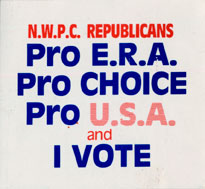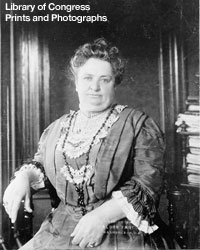
Whatever
Happened to Republican Feminists?
by Jo Freeman (1996)

 For
most of this country's history the Republican Party provided a much
warmer reception to women, and in particular those women actively
working to promote women's rights, than did the Democratic Party.
Traditionally, the Republican Party was the more feminist of the major
political parties.
For
most of this country's history the Republican Party provided a much
warmer reception to women, and in particular those women actively
working to promote women's rights, than did the Democratic Party.
Traditionally, the Republican Party was the more feminist of the major
political parties.
 Between
1970 and 1973 the parties switched sides; since then they have been
rapidly going in the opposite directions in their attitudes towards
women's rights and their programs to improve women's situation.
Between
1970 and 1973 the parties switched sides; since then they have been
rapidly going in the opposite directions in their attitudes towards
women's rights and their programs to improve women's situation.
 A
brief look at history illuminates the profundity of this switch. Most
of the women who first demanded suffrage in 1848 were involved in
the antislavery movement and vigorously supported the party which
freed the slaves.
A
brief look at history illuminates the profundity of this switch. Most
of the women who first demanded suffrage in 1848 were involved in
the antislavery movement and vigorously supported the party which
freed the slaves.
 Suffragists
were particularly active on behalf of President Grant's re-election
in 1872, William McKinley's campaign against William Jennings Bryan
in 1896, and Theodore Roosevelt's campaign against Taft and Wilson
in 1912.
Suffragists
were particularly active on behalf of President Grant's re-election
in 1872, William McKinley's campaign against William Jennings Bryan
in 1896, and Theodore Roosevelt's campaign against Taft and Wilson
in 1912.
 J. Ellen Foster
J. Ellen Foster
|

The
Republican Party saw the importance of women to winning elections
even in states where women could not vote. In 1888 the Republican
National Committee asked J. Ellen Foster, an attorney and temperance
worker from Iowa, to organize the National Woman's Republican Association.
While the Populists, the Prohibitionists and other small parties also
organized women to work for their candidates, the Democrats did little.
It was 1912 before there was a Women's National Democratic League,
and it was composed mostly of the wives of Members of Congress.
 In
the 1890s women took up the job of municipal reform. In New York the
West End Women's Republican Association worked to defeat Tammany Hall,
while the Democratic newspaper asked "Where are the Democratic
Women?" In 1894 and 1896 the Illinois Republican Women's State
Central Committee sent Ida Wells-Barnett, prominent African-American
journalist, on a lecture tour around the state on behalf of Republican
candidates. In California the Republican Party, but not the Democrats,
supported women candidates for local school boards and for suffrage.
In
the 1890s women took up the job of municipal reform. In New York the
West End Women's Republican Association worked to defeat Tammany Hall,
while the Democratic newspaper asked "Where are the Democratic
Women?" In 1894 and 1896 the Illinois Republican Women's State
Central Committee sent Ida Wells-Barnett, prominent African-American
journalist, on a lecture tour around the state on behalf of Republican
candidates. In California the Republican Party, but not the Democrats,
supported women candidates for local school boards and for suffrage.
 In
1916 militant suffragists formed the National Woman's Party to campaign
against all Democrats in the twelve states where women could vote
for President to punish them for failure to support woman suffrage.
While neither Party supported a federal suffrage amendment in its platform, Republican candidate Charles Evans Hughes endorsed one on
August 1, 1916. President Wilson didn't do so until 1918. The women
who had supported Roosevelt in 1912 formed the Women's Committee of
the Hughes Alliance and raised over $132,000 from 1,100 contributors
for their own campaign. They organized and financed a special train
to travel throughout the suffrage states holding rallies where women
orators mobilized supporters.
In
1916 militant suffragists formed the National Woman's Party to campaign
against all Democrats in the twelve states where women could vote
for President to punish them for failure to support woman suffrage.
While neither Party supported a federal suffrage amendment in its platform, Republican candidate Charles Evans Hughes endorsed one on
August 1, 1916. President Wilson didn't do so until 1918. The women
who had supported Roosevelt in 1912 formed the Women's Committee of
the Hughes Alliance and raised over $132,000 from 1,100 contributors
for their own campaign. They organized and financed a special train
to travel throughout the suffrage states holding rallies where women
orators mobilized supporters.
 Before
the days of exit polls it is hard to tell exactly how women voted,
but the few analyses that have been done indicate that there was a
gender gap in favor of the Republican Party in most places at least
until the 1930s. Indeed in the elections of 1952 and 1956 women were
six percent more likely to vote for Republican Eisenhower than men
were.
Before
the days of exit polls it is hard to tell exactly how women voted,
but the few analyses that have been done indicate that there was a
gender gap in favor of the Republican Party in most places at least
until the 1930s. Indeed in the elections of 1952 and 1956 women were
six percent more likely to vote for Republican Eisenhower than men
were.
 Women
were particularly active on behalf of Herbert Hoover in 1928. The
NWP endorsed him. Moderate suffrage leader Carrie Chapman Catt campaigned
for him. Hoover got as much as 65 percent of the women's vote.
Women
were particularly active on behalf of Herbert Hoover in 1928. The
NWP endorsed him. Moderate suffrage leader Carrie Chapman Catt campaigned
for him. Hoover got as much as 65 percent of the women's vote.
 In
the 1920s thousands of Republican Women's Clubs were organized throughout
the country. The National Federation of Republican Women was founded
in 1938 and today is one of the largest women's organizations. While
the Democrats made a major effort to organize women during FDR's first
two terms, this faded after 1940.
In
the 1920s thousands of Republican Women's Clubs were organized throughout
the country. The National Federation of Republican Women was founded
in 1938 and today is one of the largest women's organizations. While
the Democrats made a major effort to organize women during FDR's first
two terms, this faded after 1940.
 In
1940 the RNC adopted rules requiring equal representation of women
on all RNC Committees. Equal representation on the convention platform
committee became the rule in 1944, and on all convention committees
in 1960.
In
1940 the RNC adopted rules requiring equal representation of women
on all RNC Committees. Equal representation on the convention platform
committee became the rule in 1944, and on all convention committees
in 1960.
 Through
1968 women had more space in the Republican Party platform and usually
had proportionately more delegates at its national convention than
did the Democrats.
Through
1968 women had more space in the Republican Party platform and usually
had proportionately more delegates at its national convention than
did the Democrats.
 The
GOP endorsed the Equal Rights Amendment four years earlier than the
Democrats -- in 1940 -- and took it out four years later -- in 1964.
The first three Presidents to support the Equal Rights Amendment were
Republicans -- Eisenhower, Nixon and Ford.
The
GOP endorsed the Equal Rights Amendment four years earlier than the
Democrats -- in 1940 -- and took it out four years later -- in 1964.
The first three Presidents to support the Equal Rights Amendment were
Republicans -- Eisenhower, Nixon and Ford.
 During
the 1970-72 campaign for Congressional passage of the ERA two of the
most active supporters were the President of the National Federation
of Republican Women and the female co-chair of the Republican National
Committee.
During
the 1970-72 campaign for Congressional passage of the ERA two of the
most active supporters were the President of the National Federation
of Republican Women and the female co-chair of the Republican National
Committee.
 By
1980 all this had changed.
By
1980 all this had changed.
 Mary Crisp
Mary Crisp
|

At
their convention that year the Republican Party removed the ERA from
its platform a second time -- only eight years after both parties
resumed support. It actively opposed legalized abortion and generally
shunned those few Republican women still willing to call themselves
feminists. Co-chair Mary Crisp, an ERA activist who had campaigned
for Goldwater in 1964, was virtually read out of the party.
 That
November a "gender gap" in Presidential voting appeared,
with women voting more Democratic than men. Since then Republican
Members of Congress have voted increasingly against bills supported
by feminist groups, and women have voted increasingly for Democrats
over Republicans. Even when the 1984 Reagan campaign specifically
targeted women, the gender gap remained. Indeed, it spread from the
Presidential to many state and local races.
That
November a "gender gap" in Presidential voting appeared,
with women voting more Democratic than men. Since then Republican
Members of Congress have voted increasingly against bills supported
by feminist groups, and women have voted increasingly for Democrats
over Republicans. Even when the 1984 Reagan campaign specifically
targeted women, the gender gap remained. Indeed, it spread from the
Presidential to many state and local races.
 By
Spring 1996, surveys showed that sixteen percent more men identified
with the Republican Party than the Democrats, while eight per cent
more women said they were Democrats than Republicans. Even among African
Americans women were five to ten percent more likely to be Democrats
than men were. In the 1996 Presidential race, the gender gap was eleven
percent overall and 17 percent among those under 30. It spread to
many other races.
By
Spring 1996, surveys showed that sixteen percent more men identified
with the Republican Party than the Democrats, while eight per cent
more women said they were Democrats than Republicans. Even among African
Americans women were five to ten percent more likely to be Democrats
than men were. In the 1996 Presidential race, the gender gap was eleven
percent overall and 17 percent among those under 30. It spread to
many other races.
 What
happened?
What
happened?
 Although
the feminist movement wanted to be bipartisan and organized women
within both major parties, these efforts were not equally successful.
In the Democratic Party women formed alliances with those who wanted
to make their party more inclusive. In the Republican Party feminists
were swimming against the tide.
Although
the feminist movement wanted to be bipartisan and organized women
within both major parties, these efforts were not equally successful.
In the Democratic Party women formed alliances with those who wanted
to make their party more inclusive. In the Republican Party feminists
were swimming against the tide.
 That
tide was the New Right, which had been trying to take over the Republican
Party since Goldwater's campaign in 1964. In the early 1970s it had
no particular interest in women; some New Rightists were pro ERA and
pro Choice.
That
tide was the New Right, which had been trying to take over the Republican
Party since Goldwater's campaign in 1964. In the early 1970s it had
no particular interest in women; some New Rightists were pro ERA and
pro Choice.
 But
the New Right saw victory in an alliance with social conservatives
who traditionally voted Democratic, and in particular with Southerners
who did not like racial integration and the greater intrusion of government
that it led to. It wanted to leverage the backlash against social
change into a Republican vote. The New Right first recruited fundamentalist
ministers, especially in the South, who had stayed out of politics
for decades because they thought it was dirty. The ministers were
persuaded that the country's culture was being corrupted by the militant
secularists, who had captured the Democratic Party. They convinced
many of their flocks that it was the duty of all good Christians to
involve themselves in politics in order to take back their culture
and their institutions.
But
the New Right saw victory in an alliance with social conservatives
who traditionally voted Democratic, and in particular with Southerners
who did not like racial integration and the greater intrusion of government
that it led to. It wanted to leverage the backlash against social
change into a Republican vote. The New Right first recruited fundamentalist
ministers, especially in the South, who had stayed out of politics
for decades because they thought it was dirty. The ministers were
persuaded that the country's culture was being corrupted by the militant
secularists, who had captured the Democratic Party. They convinced
many of their flocks that it was the duty of all good Christians to
involve themselves in politics in order to take back their culture
and their institutions.
 Legalized
abortion expanded the backlash. When the Catholic Church mobilized
opposition to abortion, New Right leaders saw a golden opportunity
to go fishing among Catholics. Sex was added to race as a highly charged
emotional issue which could uncouple traditional Democratic voters
from the party of their birth. Indeed sex was a much better issue
than race to rouse voters out of their disenchantment with politics.
Racism was vaguely immoral; it had to be disguised as big bad government
to be palatable. Sex was more suspect. Republicans labeled feminism
as immoral sexuality -- i.e. abortion, homosexuality, mothering without
marriage -- and touted themselves as the party of "family values."
Legalized
abortion expanded the backlash. When the Catholic Church mobilized
opposition to abortion, New Right leaders saw a golden opportunity
to go fishing among Catholics. Sex was added to race as a highly charged
emotional issue which could uncouple traditional Democratic voters
from the party of their birth. Indeed sex was a much better issue
than race to rouse voters out of their disenchantment with politics.
Racism was vaguely immoral; it had to be disguised as big bad government
to be palatable. Sex was more suspect. Republicans labeled feminism
as immoral sexuality -- i.e. abortion, homosexuality, mothering without
marriage -- and touted themselves as the party of "family values."
 By
playing on the fears of change raised by feminism and the vastly changing
role of women in our society, the New Right has created a new and
potent partisan cleavage in the electorate, one which, like race,
is gradually realigning major voting blocs. It has also created a
fracture -- albeit a small one -- within the Republican Party. This
fracture centers around abortion, but in fact involves broader concerns
of sex, sexuality and the role of women. Republicans who called themselves
feminists twenty years ago now organize as "pro-choice Republicans".
Unfortunately, they are better at publicizing their concerns than
at organizing the grass roots, so it is unlikely that they will be
more than an irritant to the Republican party for many, many years.
By
playing on the fears of change raised by feminism and the vastly changing
role of women in our society, the New Right has created a new and
potent partisan cleavage in the electorate, one which, like race,
is gradually realigning major voting blocs. It has also created a
fracture -- albeit a small one -- within the Republican Party. This
fracture centers around abortion, but in fact involves broader concerns
of sex, sexuality and the role of women. Republicans who called themselves
feminists twenty years ago now organize as "pro-choice Republicans".
Unfortunately, they are better at publicizing their concerns than
at organizing the grass roots, so it is unlikely that they will be
more than an irritant to the Republican party for many, many years.
 In
the last 25 years, the two major parties have undergone a realignment,
on at least on one cluster of issues. They are now polarized around
feminism and the reaction to it, with different programs and different
visions of how to deal with sex and the role of women. The Republicans
are now the party of traditional family values, while Democrats are
following the feminist agenda of making the personal, political. Republican
feminists are left with an onerous choice: they can stay in the party
and suppress their feminist concerns, or they can leave.
In
the last 25 years, the two major parties have undergone a realignment,
on at least on one cluster of issues. They are now polarized around
feminism and the reaction to it, with different programs and different
visions of how to deal with sex and the role of women. The Republicans
are now the party of traditional family values, while Democrats are
following the feminist agenda of making the personal, political. Republican
feminists are left with an onerous choice: they can stay in the party
and suppress their feminist concerns, or they can leave.